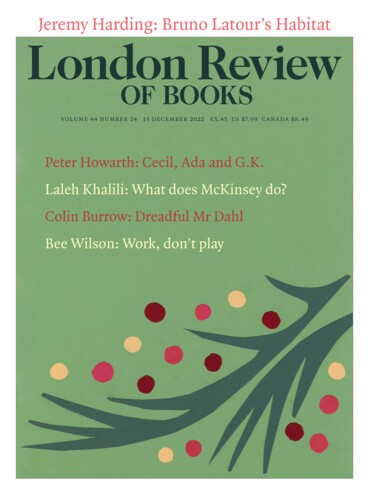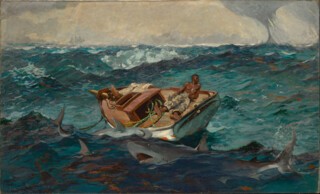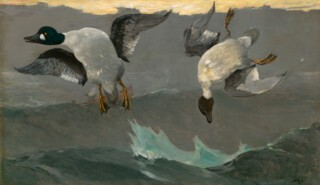At the time of his death in 1910, Winslow Homer was considered one of America’s greatest painters, yet he remains largely unknown in the UK. No work by Homer can be found in a British public collection, and the current retrospective at the National Gallery (until 8 January) is only the second exhibition of his work, though Homer painted a number of English scenes and stayed near Tynemouth in the 1880s. His late seascapes, influenced by his time in England, are striking in their condensation and clarity, and gesture towards abstraction. But just why Homer brings out these figures so distinctly – like the massive leaping fish that recur in so many of his pictures, or the flying fish to the side of the battered boat in The Gulf Stream, or the boat itself, set shallowly on the surface of an advancing wave – is never quite clear.
The paintings on display at the National converge at The Gulf Stream, which hangs in the centre of the penultimate room. The same idea directed the arrangement of the larger show at the Met earlier this year. Born in Boston in 1836, Homer first gained recognition as a commercial illustrator of the Civil War, then for realist paintings chronicling Black life during Reconstruction and provincial scenes of hunting, fishing and seaside resorts. But his most prodigious paintings draw from his travels to Florida, the Caribbean, Canada and Britain.
Homer was for many years fascinated by the oceanographer Matthew Maury’s description of the Gulf Stream. In The Physical Geography of the Sea, Maury wrote of an indigo river running north through the dirty greenish sea, faster than the Amazon, creating a visible ‘line of junction’. Homer knew from Maury that waters from all over the Atlantic and everything they carry ‘tend towards’ the Gulf Stream, so that bottles cast in the sea as far away as the west coast of Africa would eventually end up there. He also knew that the Gulf Stream is saltier than the waters surrounding it; as the semitropical stream surges north, evaporation increases its salinity. The water is unusually concentrated.
In Homer’s painting, that concentration is intense: the sea seems to solidify, the wavecrests are as sharp as sharks’ fins, the atmosphere congeals in dense masses (a waterspout takes shape on the horizon). Seafoam is compressed like rocks to founder on. The line between the warm stream and the cold sea is hard and obvious. At the centre, head turned away from us in profile, is a Black fisherman, lying on the scorched deck of his boat. The mast has snapped and the sail is piled up uselessly. The tiller is missing too. The man has nothing but a few stalks of sugarcane to sustain him – and these look more like snakes with their bright orange and green striations. It is easy to see why the show’s curators think Homer is commenting on the role of the Gulf Stream in the trade in sugar and human beings. The outline of a ship can be glimpsed on the horizon, but the man is looking the other way and it doesn’t seem likely it will save him. Homer may have added it later to appease viewers who found the painting too bleak.
The bottom third of the picture is taken up with a great wave, teeming with sharks. One swims towards us, its open mouth angled almost past the picture plane, while another appears to be thrashing against the side of the boat. Homer insisted that this wasn’t so, that the boat is in fact thirty feet away from the shark, but the perspective doesn’t work. Everything is so compacted and saturated, flattened by its own weight or crushing everything around it, that the picture loses depth and seems to bear down on us. This may be why Homer wrote, just beneath his signature, ‘At twelve feet from the picture/you can see it,’ but even at that distance the problem wouldn’t resolve itself. The Gulf Stream threatens total immersion. In any case, Homer’s instructions were often sardonic, as when he told his New York dealer that another picture could only ‘be seen properly from the opposite side of Fifth Avenue’. His point was that the picture risks overwhelming us and we ought to ‘stand back!’ – but only so it sinks in further.
Many of his late paintings put the viewer in the crosshairs. In Right and Left, a red spot in the grey zone of the horizon turns out to be the flash from a hunter’s double-barrelled shotgun aimed at the two massive ducks in mid-flight. But we, too, are in the line of fire. The ducks are given so much heft and emphasis, and everything hangs in the balance: one bird diving downwards and another rising up, its wings spread out before it falls – a split second amassed, gathered up between life and death, and shot forward.
According to the art historian Charles Colbert, the usual practice of painters in this period ‘was to let the horizon fade into visual and conceptual insignificance’. But in Homer the horizon does not recede; it pitches forward, towards our world. A red spot is not the glint of a setting sun or an artistic flourish; it is the flash of a gun muzzle – we should think ‘duck!’ when we see the ducks – or the light from a Maine lighthouse, seen from treacherous waters. Cannon Rock, which hasn’t travelled to London, shows a wave rising up on the horizon, about to burst through the opening in the rock in the near foreground (and boom like a cannon when it does). Mere background is here the focus of attention. The late seascapes that made it to the National preserve this sense of a background that has been activated – the horizon as a wave that is in the process of becoming the foreground.
What did Homer wish us to make of this? He was unwilling to engage with critics or to explain his work. In a letter to a collector who asked him to reflect on Promenade on the Beach, he replied that the two well-dressed women looking out to sea are ‘looking at anything that you wish to have them look at, but it must be something at sea & a very proper & appropriate object for Girls to be interested in’. Only a few letters survive from his first 45 years, and from the 1880s he lived a reclusive life at Prout’s Neck, Maine, with a sign on the door warning ‘SNAKES!’ to keep visitors away.
Homer’s late paintings, including The Gulf Stream, make the earlier pastoral scenes of farming and small-town life, of children playing by a little red schoolhouse or boating along the coast of a seaside village, appear less innocent, sunstruck rather than sunny, and maybe not proper objects to be interested in at all. Two boys are shown on a dizzyingly high dune, trying to count the eggs in a sand martin colony; something surely will crack? The woman in Eagle Head, Manchester, Massachusetts (High Tide) is wringing out her bathing clothes on the sand; another woman glares at her disapprovingly; the bright light casts sharp shadows and the little dog is barking anxiously. What is wrong here? Why are these summery scenes so tense? In Snap the Whip, a group of boys run in a twisting line: the object of the game is to hold as tightly as possible to your neighbour’s hand until snap, someone is cast off.
Most of Homer’s pictures are just on the sunny side of morbid. In his middle period they are almost all scenes of hanging on or holding out, of fisherwomen bracing themselves against the elements, of shipwrecks and near loss or uncertain rescue. In Undertow, figures form a human chain as rescuers try to pull ashore some swimmers who have been dragged down by their bathing clothes. The swimmers press into one another, caught between the forward pull of the rescuers and the undertow. There is no doubting how effortful it is to stay afloat. They look as heavy as marble sculptures and as sensuously modelled, with the soaked fabric clinging around buttocks and pelvis, one woman’s thumb underscoring her breast. A man with a torn shirt and exposed nipple lifts up another woman’s waterlogged dress. Everything is glistening and charged. The painting wants to impress on us the force required to bring these figures out and the monumental effort of holding them up.
There are fewer watercolours at the National Gallery than there were at the Met, but enough to demonstrate their importance to Homer’s career. Before his first large seascapes, he spent sixteen months in the fishing village of Cullercoats in Northumberland, known for its volunteer lifesaving crews, where he produced 140 watercolours of shipwrecks and storms. He studied English watercolour techniques, and reduced his own subjects to bright strokes and salient figures, overlapping blocks of wash in saturated colours, forms layered beneath the surface or emerging from the wash with minimal detail. Studying watercolour gave a dramatic concentration to Homer’s work, which critics agreed seemed heavier and more substantial after his stay in Cullercoats. One contemporary viewer said that the woman standing at the water’s edge in Inside the Bar ‘is not made of the stuff that is swept away … she is part of the storm itself.’ The remark echoes Homer’s controversial insistence that the subject of The Gulf Stream is ‘comprised in its title’, as if the man on the boat surrounded by sharks were indistinguishable from the great current and from the task of painting it. Whatever Homer meant, these threatened figures are elemental to his work.
Before he finished The Gulf Stream, one of only two Caribbean canvases, he took several trips to Cuba, Bermuda and the Bahamas, painting only watercolours, and nothing in the show is more brilliant than these: flowers, palms and fruit in startling pigments, coral and limestone walls, white sails against the blue expanse of sea. The earlier Bahamas pictures were part of an advertising campaign to attract tourists from the US, and, although some of the pictures show Black figures decidedly outside the coral walls of Nassau’s gardens (some of which were lined with glass shards to keep them out), the scenes have been dismissed as gaudy tropes of a tropical paradise. But the watercolours were useful studies in luring an audience and in making something visible that might otherwise be missed. There is almost always a spot or stroke of red that needs discerning, like the flash from the gun in Right and Left: the red scarf of a Bahamian figure in the distance or a red-coated British soldier in Bermuda who has slipped onto the edge of a cliff; the Red Ensign of empire or a red flag signalling a hurricane.
Near the end of his life, Homer painted a watercolour of a leaping channel bass (also known as red drum or ‘red’) from a shallow river on Florida’s Gulf Coast. It hangs in a room labelled ‘Mortality’, its great form looming against a lapis-blue wash. Each flashy scale is like a $20 gold piece, Homer said (he actually used gold leaf for another leaping fish). There is a bright red hook outside its mouth and we get the sense of being hooked too. At the critical moment, Homer raises a figure up and makes it momentous, just when it is about to die.
Send Letters To:
The Editor
London Review of Books,
28 Little Russell Street
London, WC1A 2HN
letters@lrb.co.uk
Please include name, address, and a telephone number.



